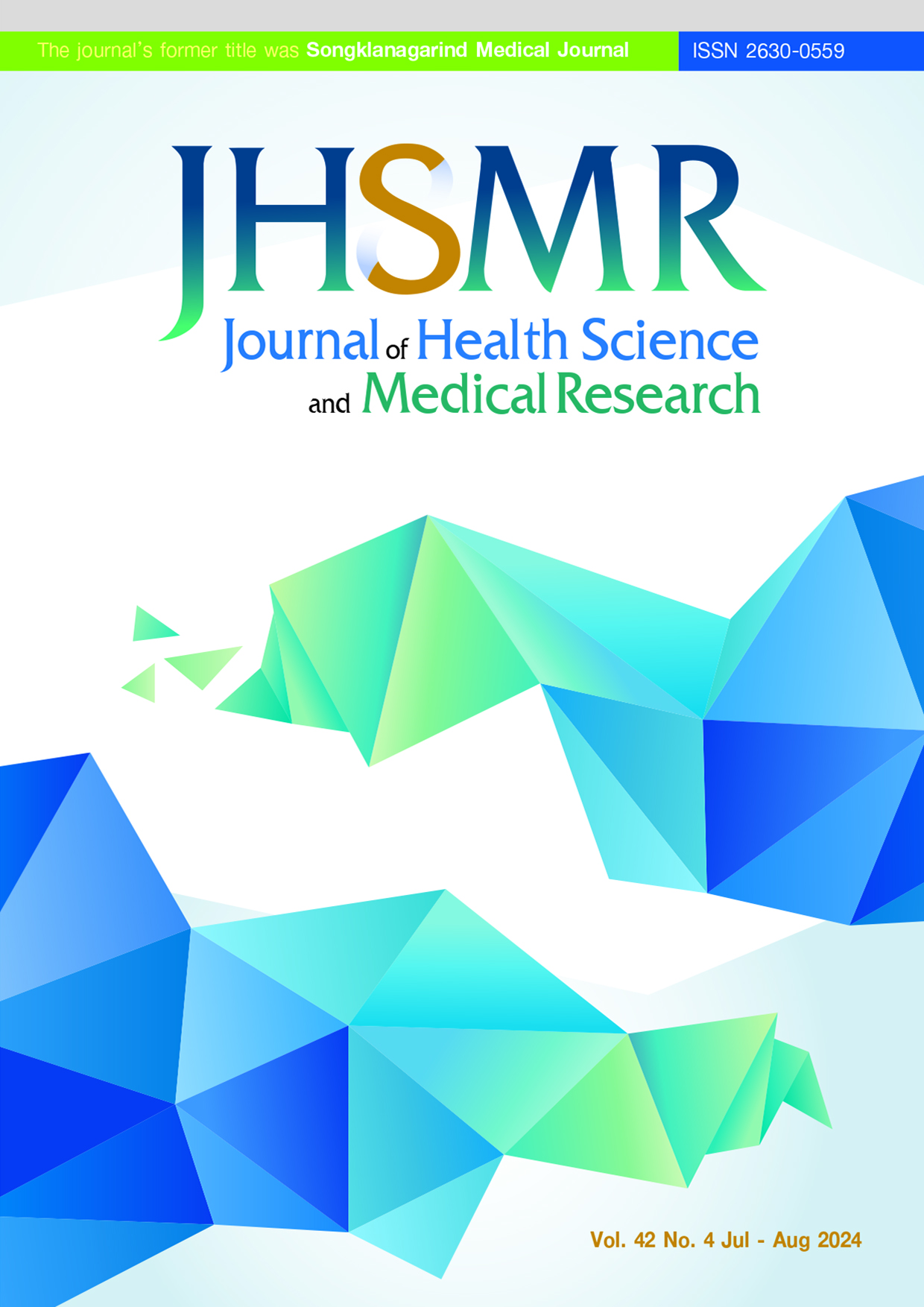Diarylheptanoid 7-(3,4-Dihydroxyphenyl)-5- Hydroxy-1-Phenyl- (1E)-1-Heptene from Curcuma Comosa Roxb. Inhibits Nucleophosmin Localization and Induces Apoptosis in KG-1a Leukemic Stem Cells
DOI:
https://doi.org/10.31584/jhsmr.20241034Keywords:
apoptosis, Curcuma comosa, cytotoxicity, diarylheptanoids, nucleophosmin, ZingiberaceaeAbstract
Objective: This study aimed to investigate the effect of the diarylheptanoid 7-(3,4-dihydroxyphenyl)-5- hydroxy-1-phenyl-(1E)-1-heptene (DDHPH) from the rhizome of Curcuma comosa Roxb. on nucleophosmin (NPM) protein localization followed by induced cell death in KG-1a leukemic stem cells.
Material and Methods: DDHPH was purified by column chromatography and characterized by nuclear magnetic resonance (NMR). Localization of NPM was determined by a confocal microscopy. Induction of cell death was determined by flow cytometry and Western blotting.
Results: A previous study showed that NPM directly interacted with p53 and activates p53 function. In this study, DDHPH was found to modify the translocation of NPM and enhance both p53 and cleaved caspase-3 expression. These proteins were found to control cell cycle progression and cell apoptosis induction.
Conclusion: This study demonstrated that DDHPH is a novel compound which induces cell death through NPM localization.
References
Boonsrangsom T. Genetic diversity of ‘Wan Chak Motluk’ (Curcuma comosa Roxb.) in Thailand using morphological characteristics and random amplification of polymorphic DNA (RAPD) markers. S Afr J Bot 2020;130:224-30.
Nakamura S, Qu Y, Xu F, Matsuda H, Yoshikawa M. Structures of new monoterpenes from Thai herbal medicine Curcuma comosa. Chem Pharm Bull 2008;56:1604-6.
Thongon N, Boonmuen N, Suksen K, Wichit P, Chairoungdua A, Tuchinda P, et al. Selective estrogen receptor modulator (SERM)-like activities of diarylheptanoid, a phytoestrogen from Curcuma comosa, in breast cancer cells, pre-osteoblast cells, and rat uterine tissues. J Agric Food Chem 2017;65:3490-6.
Suksamrarn A, Ponglikitmongkol M, Wongkrajang K, Chindaduang A, Kittidanairak S, Jankam A, et al. Diarylheptanoids, new phytoestrogens from the rhizomes of Curcuma comosa: isolation, chemical modification and estrogenic activity evaluation. Bioorg Med Chem 2008;16:6891-902.
Winuthayanon W, Piyachaturawat P, Suksamrarn A, Ponglikitmongkol M, Arao Y, Hewitt SC, et al. Diarylheptanoid phytoestrogens isolated from the medicinal plant Curcuma comosa: biologic actions in vitro and in vivo indicate estrogen receptor–dependent mechanisms. Environ Health Perspect 2009;117:1155-61.
Suksen K, Charaslertrangsi T, Noonin C, Jariyawat S, Devakul Na Ayutthaya W, Suksamrarn A, et al. Protective effect of diarylheptanoids from Curcuma comosa on primary rat hepatocytes against t-butyl hydroperoxide-induced toxicity. Pharm Biol 2016;54:853-62.
Viriyaadhammaa N, Saiai A, Neimkhum W, Nirachonkul W, Chaiyana W, Chiampanichayakul S, et al. Cytotoxic and antiproliferative effects of diarylheptanoids isolated from Curcuma comosa Rhizomes on leukaemic cells. Molecules 2020;25:5476. doi: 10.3390/molecules25225476.
Jariyawat S, Thammapratip T, Suksen K, Wanitchakool P, Nateewattana J, Chairoungdua A, et al. Induction of apoptosis in murine leukemia by diarylheptanoids from Curcuma comosa Roxb. Cell Biol Toxicol 2011;27:413-23.
Sperr W, Hauswirth A, Florian S, Öhler L, Geissler K, Valent P. Human leukaemic stem cells: a novel target of therapy. Eur J Clin Invest 2004;34:31-40.
Okuwaki M, Tsujimoto M, Nagata K. The RNA binding activity of a ribosome biogenesis factor, nucleophosmin/B23, is modulated by phosphorylation with a cell cycle-dependent kinase and by association with its subtype. Mol Biol Cell 2002;13:2016-30.
Box JK, Paquet N, Adams MN, Boucher D, Bolderson E, O’Byrne KJ, et al. Nucleophosmin: from structure and function to disease development. BMC Mol Biol 2016;17:1-12.
Lim MJ, Wang XW. Nucleophosmin and human cancer. Cancer Detect Prev 2006;30:481-90.
Di Matteo A, Franceschini M, Chiarella S, Rocchio S, Travaglini-Allocatelli C, Federici L. Molecules that target nucleophosmin for cancer treatment: an update. Oncotarget 2016;7:44821.
Li J, Sejas DP, Rani R, Koretsky T, Bagby GC, Pang Q. Nucleophosmin regulates cell cycle progression and stress response in hematopoietic stem/progenitor cells. J Biol Chem 2006;281:16536-45.
Lo SJ, Fan LC, Tsai YF, Lin KY, Huang HL, Wang TH, et al. A novel interaction of nucleophosmin with BCL2-associated X protein regulating death evasion and drug sensitivity in human hepatoma cells. Hepatology 2013;57:1893-905.
Colombo E, Marine J-C, Danovi D, Falini B, Pelicci PG. Nucleophosmin regulates the stability and transcriptional activity of p53. Nat Cell Biol 2002;4:529-33.
Termini D, Den Hartogh DJ, Jaglanian A, Tsiani E. Curcumin against prostate cancer: current evidence. Biomolecules 2020;10:1536.
Choudhuri T, Pal S, Agwarwal ML, Das T, Sa G. Curcumin induces apoptosis in human breast cancer cells through p53-dependent Bax induction. FEBS Lett 2002;512:334-40.
Shaw PH. The role of p53 in cell cycle regulation. Pathol Res Pract 1996;192:669-75.
Viriyaadhammaa N, Duangmano S, Saiai A, Tungjai M, Dejkriengkraikul P, Tima S, et al. A novel drug modulator diarylheptanoid (trans-1,7-Diphenyl-5-hydroxy-1-heptene) from Curcuma comosa Rhizomes for P-glycoprotein function and apoptosis induction in K652/ADR leukemic cells. Int J Mol Sci 2022;23:8989. doi: 10.3390/ijms23168989.
Tebbi CK. Etiology of acute leukemia: a review. Cancers (Basel) 2021;13:2256.
Popa MA, Wallace KJ, Brunello A, Extermann M, Balducci L. Potential drug interactions and chemotoxicity in older patients with cancer receiving chemotherapy. J Geriatr Oncol 2014;5:307-14.
Vagace JM, de la Maya MD, Caceres-Marzal C, de Murillo SG, Gervasini G. Central nervous system chemotoxicity during treatment of pediatric acute lymphoblastic leukemia/lymphoma. Crit Rev Oncol Hematol 2012;84:274-86.
Brodská B, Šašinková M, Kuželová K. Nucleophosmin in leukemia: consequences of anchor loss. Int J Biochem Cell Biol 2019;111:52-62.
Karimi Dermani F, Gholamzadeh Khoei S, Afshar S, Amini R. The potential role of nucleophosmin (NPM1) in the development of cancer. J Cell Physiol 2021;236:7832-52.
Ozaki T, Nakagawara A. Role of p53 in cell death and human cancers. Cancers (Basel) 2011;3:994-1013.
Kerr L, Birse-Archbold J-L, Short D, McGregor A, Heron I, Macdonald D, et al. Nucleophosmin is a novel Bax chaperone that regulates apoptotic cell death. Oncogene 2007;26:2554-62.
Ye K. Nucleophosmin/B23, a multifunctional protein that can regulate apoptosis. Cancer Biol Ther 2005;4:918-23.
Wang Z, Gall JM, Bonegio R, Havasi A, Illanes K, Schwartz JH, et al. Nucleophosmin, a critical Bax cofactor in ischemiainduced cell death. Mol Cell Biol 2013;33:1916-24.
Downloads
Published
How to Cite
Issue
Section
License

This work is licensed under a Creative Commons Attribution-NonCommercial-NoDerivatives 4.0 International License.
























